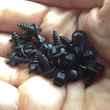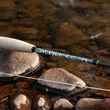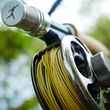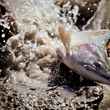We've been talking a lot about streamer tactics lately, with an eye on improving on-the-water success while fishing streamers. Almost all of the tactics we've highlighted have been founded on the same basic premise: streamers are intended to imitate prey that swims, and getting better at fooling fish with them means getting better at making your streamer look and act like the real deal, being an active predator and doing more than just covering water with a swung fly. And while we've relayed many ways to get better at doing just that, we've yet to talk about what many seasoned streamer anglers consider the most deadly streamer tactic of all: the jerk-strip.
Steamer experts like Kelly Galloup and Gary Borger have been talking about the jerk-strip for years, noting its effectiveness above all other tactics and its penchant for producing the most feverish of strikes from the biggest of trout. If that sounds good, then its time you made yourself familiar with the jerk-strip. Along with its effectiveness also comes difficulty, however. The jerk-strip retrieve is a very active retrieve that requires precise timing to master in order to produce the most accurate imitation of a fleeing baitfish.
The Jerk Strip
Unlike other retrieves, the jerk-strip utilizes the rod in imparting action to the fly. As you'd likely then guess, this is done by jerking the rod. Here's how it's usually done: rig up with a sink tip or full sinking line and cast your fly directly across stream or slightly down-and-across. Give the fly a second or two to sink in the current, and then give the rod tip a downstream jerk, moving the rod anywhere from 1 to 2 feet. Then, without pausing, return the rod to its initial position, stripping the line in simultaneously as you do. Immediately repeat the motion and continue doing so until the cast is fished out.
The motion imparted to the fly is an erratic one, intended to trigger a predatory response in fish by showing them prey that is fleeing their territory, but is compromised in some way. This prey isn't badly injured, but it is somehow vulnerable. Walking this tightrope between being an easy meal but one that's likely to get away safely if not quickly grabbed is what can trigger such violent responses from aggressive fish.
To be clear, this isn't a lazy man's streamer tactic. In fact, it is perhaps the most active way to fish a streamer. The pace should be quick and must be incredibly quick if you're dealing with fast currents. You can most certainly experiment with the pace of your jerk and speed of the following strip, but often it is the most aggressive jerk-strip retrieves that produce the most aggressive strikes from fish.
And, as noted, it takes time to master -- which is mostly a matter of getting the timing down, understanding the position and presentation of the fly in the water and getting solid hook sets when you do get a take. But here's the good news: you don't need to be a master of the jerk strip in order to have success with it. As you practice, you'll improve, and all the while you'll be producing action in the water -- that even if not perfect -- will still result in a motion that's likely to entice aggressive trout. And, you'll be experimenting with presentation and doing more than just searching water with a swung fly, which is what we've been preaching all along.
When it all comes together, you can produce some of the most impressive charges and takes you're ever likely to see as an angler and that will keep you fishing the jerk-strip retrieve on waters far and wide.































Comments
Steve Potischman replied on Permalink
An accompanying video or link to a video shoqing the technique would be helpful
Les replied on Permalink
I've fished streamers with a 6, 7, and 8-weight rods. Which of these do you use above all others for your streamer fishing for trout on medium-sized streams? Thanks!
Chad Shmukler replied on Permalink
Personally, I prefer a 6 weight when not fishing streamers on a sink tip. When using a sink tip I prefer a 7.
Les replied on Permalink
Thanks, Chad. I appreciate your input. What about when using a poly leader?
Pages